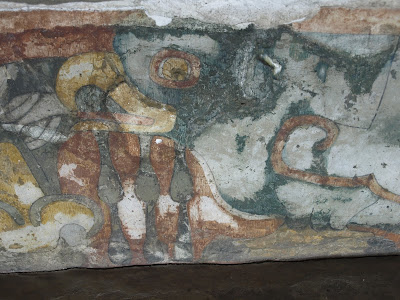highway 132 leading to the pyramids
 |
| Tiny flowers growing in the ruins |
 |
| Marie and tomb lining the Ave of the Dead |
 |
| Me resting between two cactii, Pyramid of the Sun behind me |
Fer, Rosio & Phil in front of the Pyramid of the Moon
This very important site we visited on Day 4 while in Mexico City, an hours drive north on highway 132. It was a hot December day and the sun beat down as we walked down the rough road leading to the Pyramids. It was an old place before the Aztecs arrived in the 13th century and had been long abandoned. Teotihuacán was one of the largest cities of the world during the first millennium C.E., when it had a population of 100,000 to 150,000. The pyramids were constructed around 150 C.E. and were abandoned around 600. Unlike the pyramids of Egypt, the pyramids at Teotihuacan aren't build of solid stone, instead they consist of stone and brick rubble covered with layers of cut stone, all done without the benefit of pack animals, metal tools or the wheel. Teotihuacán had lain in ruins for nearly six centuries when the nomadic Mexica tribes, the Aztecs, wandered into the Valley of Mexico. By their own accounts they believed Teotihuacán to be the birthplace of the gods (in Nahuatl, Teotihuacán means "Place of the Gods"). In reality they probably knew little more about the site than we know today, despite nearly a century of excavation. When the Aztecs uncovered it from the thick growth that lay over it they used it for their own purposes, naming the two pyramids according to their own beliefs: The Pyramid of the Sun and The Pyramid of the Moon. The long main thoroughfare we now walked they called the Avenue of the Dead as they thought it was lined with tombs, which they were. The full significance of the Pyramid of the Sun only became clear to archaeologists in the early 1970s, when a tunnel was accidentally discovered at the foot of the main staircase. This tunnel led directly toward the center of the pyramid's base, where six chambers or caves were discovered. Originally believed to be natural springs, these "caves" are now known to be completely man-made, and to date back to the earliest date of the pyramid's construction. Excavations at the smaller Pyramid of the Moon have found burial sites - full of the remains of foreign warriors, mammals, reptiles and birds of prey. The victims were all ritually killed to consecrate each stage of the pyramid's construction. On the days of the fall and spring equinox, Teotihuacán is packed with people who dress in white and climb to the top. According to Cesar, who explained this to me, they stand at the top with arms outstretched to receive the special energy of the site on that day. The Pyramid of the Sun is nearly 200 feet high and 700 feet wide and with an estimated weight of three million tons! Since we have been there I have found out that because of the building method a lot of reconstruction was needed to get it to its current state, and there's alot of uncertainty about its original appearance as we saw it.
We climbed up to the top together - over 250 steps - and had some wonderful views. It is actually higher than a 21 storey building, and the altitude at this location makes it seem even higher! From our vantage point we could admire the surrounding countryside, the mountains and the Pyramid of the Moon.
 |
Cesar atop the Pyramid of the Sun - don't back up!
|
 |
| Cesar at entrance to Quetzalpapalotl |
Sign leading to tombs - click picture to read
Detail of wall painting
Outside La Gruta
Inside La Gruta
When we left we were thirsty and hungry and the chilly dim La Gruta restaurant, just a few hundred yards away, had cold beer! It is located in a deep cave, but the brightly colored furniture, table linens and candles really make the space burst with life! A nice way to end an afternoon of exploring! gws








